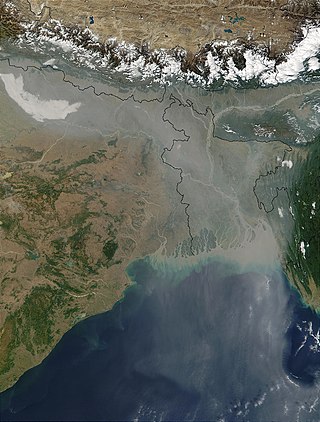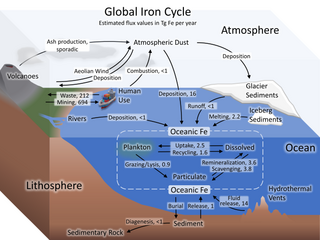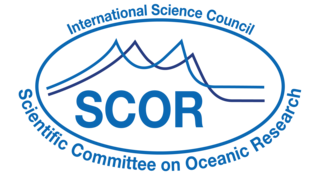Related Research Articles

A biogeochemical cycle, or more generally a cycle of matter, is the movement and transformation of chemical elements and compounds between living organisms, the atmosphere, and the Earth's crust. Major biogeochemical cycles include the carbon cycle, the nitrogen cycle and the water cycle. In each cycle, the chemical element or molecule is transformed and cycled by living organisms and through various geological forms and reservoirs, including the atmosphere, the soil and the oceans. It can be thought of as the pathway by which a chemical substance cycles the biotic compartment and the abiotic compartments of Earth. The biotic compartment is the biosphere and the abiotic compartments are the atmosphere, lithosphere and hydrosphere.

Cloud condensation nuclei (CCNs), also known as cloud seeds, are small particles typically 0.2 μm, or one hundredth the size of a cloud droplet. CCNs are a unique subset of aerosols in the atmosphere on which water vapour condenses. This can affect the radiative properties of clouds and the overall atmosphere. Water vapour requires a non-gaseous surface to make the transition to a liquid; this process is called condensation.

Biogeochemistry is the scientific discipline that involves the study of the chemical, physical, geological, and biological processes and reactions that govern the composition of the natural environment. In particular, biogeochemistry is the study of biogeochemical cycles, the cycles of chemical elements such as carbon and nitrogen, and their interactions with and incorporation into living things transported through earth scale biological systems in space and time. The field focuses on chemical cycles which are either driven by or influence biological activity. Particular emphasis is placed on the study of carbon, nitrogen, oxygen, sulfur, iron, and phosphorus cycles. Biogeochemistry is a systems science closely related to systems ecology.
The Surface Ocean Lower Atmosphere Study (SOLAS) is a global and multidisciplinary research project dedicated to understanding the key biogeochemical-physical interactions and feedbacks between the ocean and the atmosphere. Further, SOLAS seeks to link ocean-atmosphere interactions with climate and people. Achievements of these goals are essential in order to understand and quantify the role that ocean-atmosphere interactions play in the regulation of climate and global change.

The iron cycle (Fe) is the biogeochemical cycle of iron through the atmosphere, hydrosphere, biosphere and lithosphere. While Fe is highly abundant in the Earth's crust, it is less common in oxygenated surface waters. Iron is a key micronutrient in primary productivity, and a limiting nutrient in the Southern ocean, eastern equatorial Pacific, and the subarctic Pacific referred to as High-Nutrient, Low-Chlorophyll (HNLC) regions of the ocean.

Dimethyl sulfide (DMS) or methylthiomethane is an organosulfur compound with the formula (CH3)2S. It is the simplest thioether and has a characteristic disagreeable odor. It is a flammable liquid that boils at 37 °C (99 °F). It is a component of the smell produced from cooking of certain vegetables, notably maize, cabbage, beetroot, and seafoods. It is also an indication of bacterial contamination in malt production and brewing. It is a breakdown product of dimethylsulfoniopropionate (DMSP), and is also produced by the bacterial metabolism of methanethiol.

The Max Planck Institute for Chemistry is a non-university research institute under the auspices of the Max Planck Society in Mainz, Germany. It was created as the Kaiser Wilhelm Institute for Chemistry in 1911 in Berlin.

The CLAW hypothesis proposes a negative feedback loop that operates between ocean ecosystems and the Earth's climate. The hypothesis specifically proposes that particular phytoplankton that produce dimethyl sulfide are responsive to variations in climate forcing, and that these responses act to stabilise the temperature of the Earth's atmosphere. The CLAW hypothesis was originally proposed by Robert Jay Charlson, James Lovelock, Meinrat Andreae and Stephen G. Warren, and takes its acronym from the first letter of their surnames.
Marine chemistry, also known as ocean chemistry or chemical oceanography, is the study of the chemical composition and processes of the world’s oceans, including the interactions between seawater, the atmosphere, the seafloor, and marine organisms. This field encompasses a wide range of topics, such as the cycling of elements like carbon, nitrogen, and phosphorus, the behavior of trace metals, and the study of gases and nutrients in marine environments. Marine chemistry plays a crucial role in understanding global biogeochemical cycles, ocean circulation, and the effects of human activities, such as pollution and climate change, on oceanic systems. It is influenced by plate tectonics and seafloor spreading, turbidity, currents, sediments, pH levels, atmospheric constituents, metamorphic activity, and ecology.

Ulrich "Uli" Pöschl is an Austrian chemist who was appointed Director of the newly founded Department of Multiphase Chemistry at the Max Planck Institute for Chemistry in Mainz, Germany on 1 October 2012.
Mary Ann Moran is a distinguished research professor of marine sciences at the University of Georgia in Athens. She studies the role of bacteria in Earth's marine nutrient cycles, and is a leader in the fields of marine sciences and biogeochemistry. Her work is focused on how microbes interact with dissolved organic matter and the impact of microbial diversity on the global carbon and sulfur cycles. By defining the roles of diverse bacteria in the carbon and sulfur cycles, she connects the biogeochemical and organismal approaches in marine science.

Marine biogeochemical cycles are biogeochemical cycles that occur within marine environments, that is, in the saltwater of seas or oceans or the brackish water of coastal estuaries. These biogeochemical cycles are the pathways chemical substances and elements move through within the marine environment. In addition, substances and elements can be imported into or exported from the marine environment. These imports and exports can occur as exchanges with the atmosphere above, the ocean floor below, or as runoff from the land.
Jennifer G. Murphy is a Canadian environmental chemist and an associate professor at the University of Toronto. She is known for her research how air pollutants such as increased reactive nitrogen affect the global climate.

The North Atlantic Aerosols and Marine Ecosystems Study (NAAMES) was a five-year scientific research program that investigated aspects of phytoplankton dynamics in ocean ecosystems, and how such dynamics influence atmospheric aerosols, clouds, and climate. The study focused on the sub-arctic region of the North Atlantic Ocean, which is the site of one of Earth's largest recurring phytoplankton blooms. The long history of research in this location, as well as relative ease of accessibility, made the North Atlantic an ideal location to test prevailing scientific hypotheses in an effort to better understand the role of phytoplankton aerosol emissions on Earth's energy budget.

Nadine Unger is a Professor of Atmospheric Chemistry at the University of Exeter. She has studied the role of human activities and forests on the Earth's climate.

Eugen Seibold is a German research vessel designed for contamination-free sampling of seawater, plankton, and air. Starting from 2018, exchange processes between atmosphere and ocean are studied. The vessel has been funded by the Werner Siemens Foundation and is operated by the Max Planck Institute for Chemistry (MPI) in Mainz.

The arsenic (As) cycle is the biogeochemical cycle of natural and anthropogenic exchanges of arsenic terms through the atmosphere, lithosphere, pedosphere, hydrosphere, and biosphere. Although arsenic is naturally abundant in the Earth's crust, long-term exposure and high concentrations of arsenic can be detrimental to human health.

The Scientific Committee on Oceanic Research (SCOR) is an interdisciplinary body of the International Science Council. SCOR was established in 1957, coincident with the International Geophysical Year of 1957-1958. It sought to bring scientists together to answer key ocean science questions and improve opportunities for marginalised scientists.
Colin Dermot O'Dowd is an Irish physicist and atmospheric scientist.
Patricia Ana Matrai is a marine scientist known for her work on the cycling of sulfur. She is a senior research scientist at Bigelow Laboratory for Ocean Sciences.
References
- ↑ Employee profile Archived 2017-01-26 at the Wayback Machine , MPIC, retrieved 2015-07-10.
- ↑ AAAS Members Elected as Fellows, December 18, 2009, retrieved 2015-07-10.
- ↑ Newly elected members, American Academy of Arts and Sciences, April 2013, retrieved 2015-07-10.
- ↑ AGU (January 30, 2015), "Meinrat O. Andreae Receives 2014 Waldo E. Smith Award", Eos, 96, doi: 10.1029/2015EO022949 .